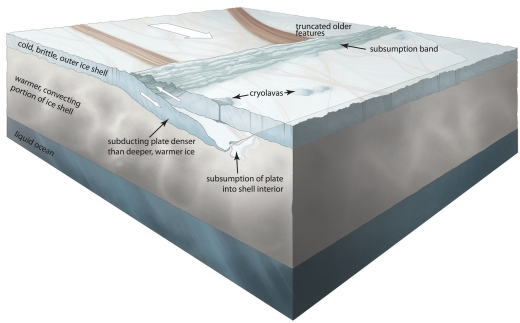Centauri Dreams
Imagining and Planning Interstellar Exploration
Europa: Two Takes on Plate Tectonics
Could plate tectonics occur on Europa? It’s an intriguing notion because the surface crust of the Saturnian moon offers oxidants and other chemicals useful for life. The process called subduction, in which a tectonic plate slides underneath another plate and sinks, would offer a way for these materials to come into contact with the subsurface ocean. We would have, in other words, a first-class mechanism for feeding the ocean with nutrients.
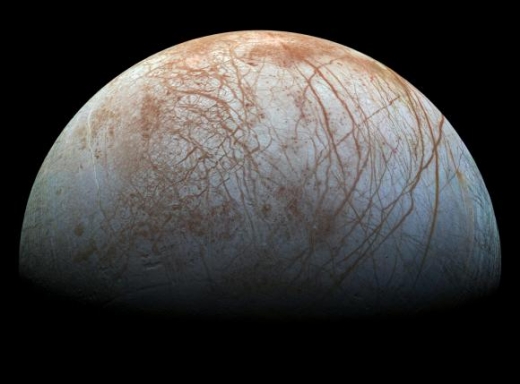
Image: Previous studies have hinted that something like subduction may have been happening on Jupiter’s moon, Europa. A new study provides geophysical evidence that it could indeed be happening on the moon’s icy shell. Credit: NASA/JPL-Caltech/SETI Institute.
There has been earlier evidence of possible plate tectonic activity on Europa, based on studies of surface geology. In places, the icy crust seems to be expanding, and here we can draw an analogy with mid-ocean ridges on Earth, which spread as a result of tectonic activity. In our oceans, material from the crust can sink into the mantle because it is cooler than the mantle material, and therefore denser. Negative buoyancy results, empowering subduction.
A temperature gradient could be in play on Europa. One line of thinking is that the ice shell on the moon is bi-layered, with the thin and cold outer layer atop a somewhat warmer layer of convective ice. Push colder ice from the surface into the warmer ice and it would sink until it warmed to the temperature of the ice around it. The image below illustrates how this might work, and is based on work that was done in 2014.
Image: A subduction model for Europa based on temperature, drawing on a 2014 paper by Simon Kattenhorn (University of Idaho) and Louise Prockter (JHU/APL), This conceptual illustration of the subduction process shows how a cold, brittle, outer portion of Europa’s 20-30 kilometer-thick ice shell moved into the warmer shell interior and was ultimately subsumed. A low-relief subsumption band was created at the surface in the overriding plate, alongside which cryolavas may have erupted. Credit: Noah Kroese, I.NK.
But a new study out of Brown University hints at another, perhaps more robust option. The work of Brandon Johnson, who developed it with the help of graduate students in a class on ocean worlds he was teaching, the paper looks at differences in salt content on Europa. The team’s computer modeling tracked the temperature and compacting of ice as it sinks into warmer ice below, analyzing density changes as warm ice becomes easier to compact. The temperature, salt content and level of ice compaction determine the buoyancy of the ice.
Johnson’s work shows that variations in salt content in Europa’s ice shell of no more than a few percent can cause subduction to occur. Moreover, we have several mechanisms for producing these variations in salt, with upwellings of water from the ocean — suggested by surface geology — offering similarities to magma rising from Earth’s mantle. This process, along with possible cryovolcanism, could deliver salty ocean water directly onto the surface.
Thus we have a mechanism for making salt variations global on Europa, and a process that can feed the ocean below with nutrients. If subduction is occuring on Europa, it would not necessarily be dependent on temperature differences. Or perhaps both processes are in play. In any case, Europa would be only the second place in the Solar System where plate tectonics occurs, and it would carry astrobiological implications. “If indeed there’s life in that ocean, subduction offers a way to supply the nutrients it would need,” Johnson says, and adds:
“It’s fascinating to think that we might have plate tectonics somewhere other than Earth. Thinking from the standpoint of comparative planetology, if we can now study plate tectonics in this very different place, it might be able to help us understand how plate tectonics got started on the Earth.”
The paper is Johnson et al., “Porosity and salt content determine if subduction can occur in Europa’s ice shell,” accepted at the Journal of Geophysical Research: Planets 4 December 2017 (abstract). The earlier Kattenhorn and Prockter paper is “Evidence for subduction in the ice shell of Europa,” Nature Geoscience 7 (2014), 762-767 (abstract).

Voyager and Mission Longevity
Sometimes it’s helpful to look back at the original intent of a space mission. Extending missions is all about continuing to do good science, and it’s often a major benefit of missions as successful as Voyager. But consider the Voyager parameters when the two craft launched in 1977. The plan: Study Jupiter and Saturn, as well as their larger moons and Saturn’s rings, with spacecraft that were built to last five years.
That primary mission, of course, was completed and led on to Voyager 2’s flybys of Uranus and Neptune, and Voyager 1’s crossing into the interstellar medium, a 40-year mission still returning data. Voyager 2 will make a similar crossing within the next few years.
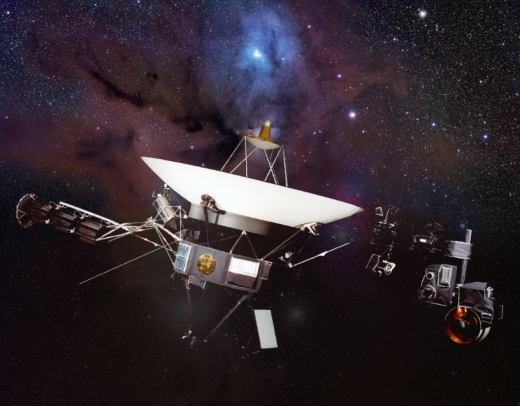
I’ve said a lot about Voyager in this space and have even advocated a final thruster burn for each when the two craft reach the end of their energy supplies, in a purely symbolic trajectory change that would bring them closer to nearby stars than they otherwise would travel (see Voyager to a Star).
This goes back to a Carl Sagan notion that Jim Bell also discussed in his book The Interstellar Age (Dutton, 2015). The two stars in question are Gliese 445 (Voyager 1) and Ross 248 (Voyager 2). Here’s a snip from my essay on the matter:
Carl Sagan and the team working on the Voyager Golden Record wondered whether something could be done about the fact that neither Voyager was headed for another Solar System. Is it possible that toward the end of the Voyagers’ active lifetimes (somewhere in the 2020s), we could set up a trajectory change that would eventually lead Voyager as close as possible to one of these stars? Enough hydrazine is available on each craft that, just before we lose radio contact with them forever, we could give them a final, tank-emptying burn. Tens of thousands of years later, the ancient craft, blind, mute but still more or less intact, would drift in the general vicinity of a star whose inhabitants, if any, might find them and wonder.
As I said, purely symbolic, but I think the symbol is powerful. But someday we’ll be sending craft on long-duration missions with the hopes of delivering more than an ancient, silent relic. We’ll want deep journeys coupled with robust data return. Thus a key question for any deep space travel is the lifetime of a spacecraft, and what a heartening example the Voyagers have set by outlasting their original parameters. Can we really build craft that could return data for centuries on missions as far out as the Oort Cloud, or beyond?
Firing Up Voyager
We learn with each new mission, but in terms of Voyager, we’ve just been given another example of how robust even these early spacecraft are. In a move that scientists believe will extend the lifetime of Voyager 1 by two to three years, engineers have fired backup thrusters that have not been used for 37 years. Made by Aerojet Rocketdyne, Voyager’s MR-103 thrusters were highly useful during the Jupiter and Saturn flybys, orienting the craft as they made observations of the planets and their huge number of moons.
The trajectory correction maneuver (TCM) thrusters are located on the back side of the spacecraft, identical to the craft’s attitude control thrusters, but because Voyager 1’s last planetary flyby was at Saturn, there had been no need to use them since November 8, 1980. During the Saturn encounter they were in continuous firing mode rather than the short bursts that the attitude control thrusters normally employ.
On November 28, 2017 engineers fired the four TCM thrusters on Voyager 1 and tested spacecraft orientation changes using 10-millisecond pulses. A wait of 19 hours and 35 minutes followed, reminding us just how far from home (141.3 AU, or 21.1 billion kilometers from Earth as of this morning) Voyager 1 now travels. But the TCM thrusters worked without flaw.
Waking up these thrusters is fascinating in its own right, but it was also a necessary move. The attitude control thrusters on Voyager 1 had been degrading, requiring more firing to achieve the same effect. In any case, Voyager 1 was already using its set of backup attitude thrusters.
But switching to the TCM thrusters to perform spacecraft orientation wasn’t cut and dried. It required unearthing data that hadn’t been examined in decades. Given the amount of time since the original software was written, the Voyager team had to wade into assembler language that is now long outdated. Todd Barber, a propulsion engineer on the mission at JPL, catches a bit of the mood as the news of successful operation finally came in:
“The Voyager team got more excited each time with each milestone in the thruster test. The mood was one of relief, joy and incredulity after witnessing these well-rested thrusters pick up the baton as if no time had passed at all.”
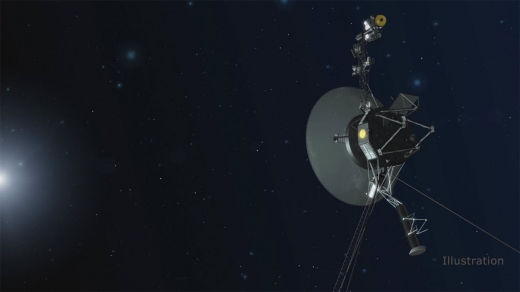
Image: An artist concept depicting one of NASA’s twin Voyager spacecraft. Humanity’s farthest and longest-lived spacecraft are celebrating 40 years in August and September 2017. Credit: NASA/JPL-Caltech.
Now that the TCM thrusters have been tested, the plan is to switch to them in January, although there is a price: Voyager 1 will need to turn on one heater per thruster, itself a use of precious power. When the heaters are no longer an option, the plan will be to switch back to the attitude control thrusters. A similar test will probably take place for Voyager 2.
Can we build spacecraft capable of enduring generations as they tackle increasingly distant missions beyond the Solar System? The evidence from the Voyagers is that the idea is realistic. What a tribute to the original engineering of these craft that they are still in the news.

Problems with Red Dwarf Habitable Zones
Why all the fuss about red dwarf planets? We’re seeing so much ongoing work on these worlds because when it comes to terrestrial-class planets — in size, at least — those around red dwarfs are going to be our first targets for atmospheric characterization. A ‘habitable zone’ planet around a red dwarf throws a deep transit signature — small star, big planet — so that we can use transit spectroscopy to puzzle out atmospheric components. Getting an actual image would be even better, and modifications to the VISIR instrument at ESO’s Very Large Telescope, a project Breakthrough Initiatives is involved in along with the ESO, could eventually yield such.

We’ll know a great deal more about the possibilities as new missions come online, but for now, researchers are doing their best to apply models to what we know and deduce what surface conditions may be like around stars like TRAPPIST-1 and Proxima Centauri. Some of these results are not auspicious if it’s life we’re looking for. I’m looking at two papers from Chuanfei Dong (Princeton Plasma Physics Laboratory/Princeton University) that assess potential habitability, and in both cases there are significant reasons to question its likelihood.
Image: Princeton’s Chuanfei Dong. Credit: Princeton Plasma Physics Laboratory.
The assumption here is that an atmosphere must exist for long timescales to allow habitable conditions on the surface, and those long time-frames are precisely what is in question. Published earlier this year in the Astrophysical Journal Letters, the first of these papers develops models of the stellar wind, that outflow of charged particles that, in our own Solar System, defines the heliosphere around our Sun. This paper deals with the situation at Proxima Centauri b. The second paper, not yet published but available as a preprint, extends the study to the TRAPPIST-1 system, with results that are equally challenging for life.
While we have tended to focus habitability studies on factors like surface temperature (and this, in turn, is much dependent on atmosphere), Dong and colleagues are concerned about the effects of the stellar wind and atmosphere retention. Their simulations, performed using magneto-hydrodynamical (MHD) modeling that was originally developed for Venus and Mars, allow them to compute ion escape losses that would be expected at Proxima Centauri b.
Specifically, the Proxima paper examines the electromagnetic erosion of the atmosphere given the photo-chemical effects of the stellar wind, finding that the stellar inflow can ionize atoms in the planetary atmosphere, allowing these electromagnetic forces to sweep them into space. The result: Potentially severe atmospheric loss that would deplete the atmosphere of evaporated water, a cycle that could eventually leave the planetary surface dry.
A sufficiently high stellar wind pressure could cause extensive atmospheric loss, making any surface-based life that emerged a short-lived phenomenon. Says Dong:
“The evolution of life takes billions of years. Our results indicate that Proxima Centauri b and similar exoplanets are generally not capable of supporting an atmosphere over sufficiently long timescales when the stellar wind pressure is high. It is only if the pressure is sufficiently low, and if the exoplanet has a reasonably strong magnetic shield like that of the Earth’s magnetosphere, that the exoplanet can retain an atmosphere and has the potential for habitability.”
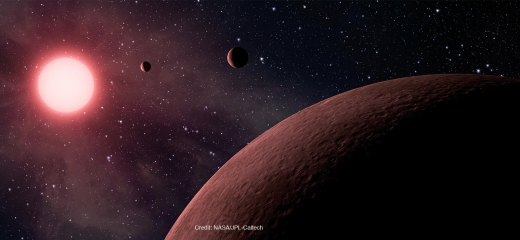
Image: Is the stellar wind capable of reducing a planetary atmosphere to the point where surface life is impossible? Credit: NASA/JPL-Caltech.
The paper finds that ion escape rates at Proxima b are two orders of magnitude higher than the terrestrial planets of our Solar System, assuming that the planet is unmagnetized. But even in the presence of a magnetosphere, ion escape rates are still higher than any we see in our system’s planets. The same issues apply at TRAPPIST-1, as noted in the new paper, which implicates stellar wind values as the primary driver in ion escape:
…as seen from our Solar system, the ion escape rates for Venus, Mars and Earth are similar despite their compositions, sizes and magnetic field strengths being wildly dissimilar (Lammer, 2013; Brain et al., 2016), thereby indicating that the ion escape rates may be more sensitive to stellar wind parameters; this is also partly borne out by the atmospheric ion escape rate calculations for Proxima b (Airapetian et al., 2017; Dong et al., 2017). Second, we observe that the inner planets of the TRAPPIST-1 system could have experienced significant losses of H2 and water over fast timescales (Bolmont et al., 2017; Bourrier et al., 2017), leaving behind other atmospheric components…
Dong also notes that planets close enough to be in a red dwarf’s habitable zone are likely tidally locked, producing constant bombardment on the star-facing side that would intensify the effects of atmospheric loss whether or not the planet has a protective magnetosphere. Earlier work has suggested that tidally locked planets are unlikely to have more than a weak magnetic field.
I’m focusing now on the TRAPPIST-1 paper because it’s the latest work on this matter, and it amplifies what was found in the earlier Proxima Centauri b work; I give citations for both papers below. Considering TRAPPIST-1 in light of stellar winds, the researchers argue that TRAPPIST-1h, viewed purely from the perspective of atmospheric loss, is the one most likely to have retained its atmosphere, but this is not a world where liquid water is possible on the surface. Dong and colleagues believe that TRAPPIST-1g thus represents “…the best chance for a habitable planet in this planetary system to support a stable atmosphere over long periods,” as the stellar wind effects diminish with distance.
It’s not a pleasant picture for those hoping for clement conditions on other planets around TRAPPIST-1 or Proxima Centauri. Oceans may once have existed there, but this work suggests that their surfaces today are probably dry. While the two papers focus on Proxima b and the TRAPPIST-1 worlds, Dong notes that the newly discovered planet around Ross 128 may have better prospects, as its star appears to be quieter than Proxima Centauri or TRAPPIST-1.
We should also note that an atmosphere can be replenished by outgassing, a reminder that analyzing an atmosphere over billion-year timeframes demands, as the paper notes, “…an in-depth understanding of the interplay between source and loss mechanisms.” Another issue: Stellar properties evolve, so that atmospheric escape rates change. This may not work to life’s advantage, however, for pre-main sequence M-dwarfs, according to Dong’s simulations, would produce even stronger stellar wind effects upon a young planet’s atmosphere.
The implications for other planetary systems seem clear:
For a given star, the mass-loss rate is fixed, implying that the escape rate is lower for smaller planets orbiting at greater distances. Hence, we suggest the following strategy for prioritizing studies of multi-planetary systems. If more than one exoplanet resides within the HZ of a given star, it may be more prudent to focus on the outward planet(s) since the atmospheric escape rates are likely to be lower. Similarly, when confronted with two planets with similar values of Rx and a [radius and semi-major axis], we propose that searches should focus on stars with lower mass-loss rates and magnetic activity.
The examination of the effects of stellar winds will proceed with soon-to-be-launched missions like the James Webb Space Telescope, allowing us to put theoretical work to the test. Given the surprises we’ve consistently found even with our interplanetary probes, Pluto being the most recent example, we can fairly confidently expect to modify our views with each new exoplanet atmospheric characterization. For now, though, these continuing studies raise serious questions about red dwarf planets as a clement venue for life.
The papers are Dong et al., “Is Proxima Centauri b habitable? — A study of atmospheric loss,” Astrophysical Journal Letters Vol. 837, No. 2 (10 March 2017) (abstract/ preprint); and Dong et al., “Atmospheric escape from the TRAPPIST-1 planets and implications for habitability,” accepted at Astrophysical Journal Letters (preprint).

Ozone Problematic for Biosignature Detection
TRAPPIST-1 and its seven interesting planets may be the most compelling stellar system we’re investigating, given the range of worlds here and the possibilities for analyzing an entire, nearby planetary system. But as we look toward examining systems like this with new space- and ground-based instruments, we may run into problems with searching for biosignatures. Both the TRAPPIST-1 planets and the promising Proxima Centauri b may be tough to characterize.
The problem: When searching for biosignatures, we’re looking for signs of metabolism, gases that are continually produced and remain out of balance in a planetary atmosphere. Ozone is one piece of the puzzle, one that signifies oxygen. Finding the latter in the same atmosphere with methane would be a compelling biosignature. But ozone could be hard to detect.
Ludmila Carone (Max Planck Institute for Astronomy) and colleagues now find that atmospheric circulation in planets close enough to red dwarfs to be in their habitable zone may mask the very signs we’re looking for. Ozone may become undetectable, trapped in equatorial regions.
The issue involves atmospheric flows, which will likely differ from what we see on Earth. The ozone in our stratosphere is formed when ultraviolet light from the Sun triggers chemical reactions in the oxygen molecules that make up approximately one-fifth of our atmosphere. The ozone protects us from harmful ultraviolet radiation from the Sun, and is distributed throughout the atmosphere owing to large-scale air flows moving from the equatorial regions to the poles.
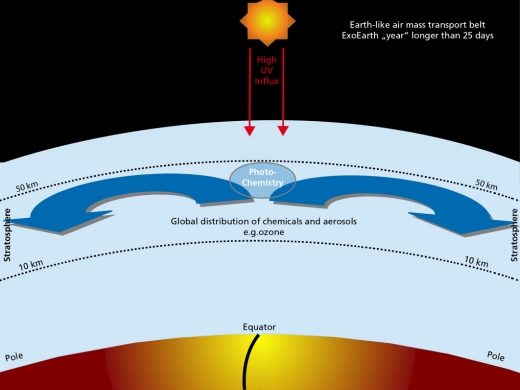
Image: Earth’s atmosphere has a “transportation belt” of air flows which move ozone from the main production areas near the equator towards the poles. This mechanism is important for creating Earth’s global ozone layer. Credit: MPIA (L. Carone & Graphics Dept.)
The problem for exoplanetology is that red dwarf planets in orbits of less than 25 days may be tidally locked to their star, presenting the same face to it at all times. Tidal lock, which we’ve examined often in these pages, could conceivably still allow enough heat to circulate to avoid the kind of extremes between dark and light sides that could prevent life from emerging. But for planets like these, Carone’s models show major air flows moving in the opposite direction, from the poles to the equator. The ozone we seek, then, could be trapped in the equatorial region.
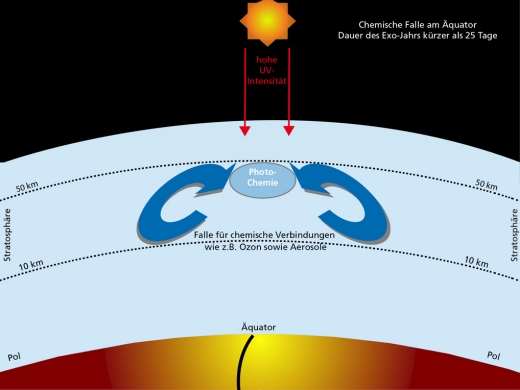
Image: As a new study by Ludmila Carone shows, certain exoplanets could have air flows that serve to trap ozone in the equatorial regions. This could present an unforeseen complication for the search for traces of life on these planets. For those who don’t speak German — my apologies, but I only have this image with German annotation. Credit: MPIA (L. Carone & Graphics Dept.)
This possibility is one we’ll need to consider as we begin the analysis of atmospheres on terrestrial-class planets around nearby red dwarfs. We may find no ozone on planets where ozone and oxygen might actually exist, though sequestered in places that might be difficult to detect. That’s a reverse take on the usual ‘false positive’ problem we’ve discussed here before, with abundant oxygen, for example, not necessarily being a marker for biological activity.
On the other hand, it’s worth asking whether a planet with ozone only in its equatorial regions would be capable of developing life in the first place. On that score, Carrone has an answer:
“In principle: yes. Proxima b and TRAPPIST-1d orbit red dwarfs, reddish stars that emit very little harmful UV-light to begin with. On the other hand, these stars can be very temperamental, and prone to violent outbursts of harmful radiation including UV. There is still a lot that we don’t know about these red dwarf stars. But I’m confident we will know much more in five years.”
True enough, assuming a successful launch of instruments like the James Webb Space Telescope, and the gradual emergence of the next generation of ground-based instruments. But as a marker for oxygen and potential life, exoplanet ozone may be a challenging detection.
The paper is Carone et al., “Stratosphere circulation on tidally locked ExoEarths,” Monthly Notes of the Royal Astronomical Society Vol. 473, Issue 4, pp. 4672-4685 (abstract).

Thinking About Saturn After Cassini
Several recent news items on Enceladus have me wanting to catch up with mission possibilities and the instruments that will drive them. NASA’s thinking in that direction takes in a remote sensing instrument called SELFI, an acronym standing for Submillimeter Enceladus Life Fundamentals Instrument. The plan here is to examine the chemical composition of the plumes of water vapor and icy particles that are regularly lofted into space from Enceladus’ south pole, in the region we’ve come to know as the ‘tiger stripes.’
Cassini data on the slight wobble in the orbital motion of Enceladus backs up the idea that the ocean beneath its ice is global, a body likely kept liquid by tidal energies as the moon is pulled and squeezed by Saturn in its orbit. The same process is likely the cause of the cracks that allow ocean water to escape into space, from perhaps as many as 100 sites on the surface.
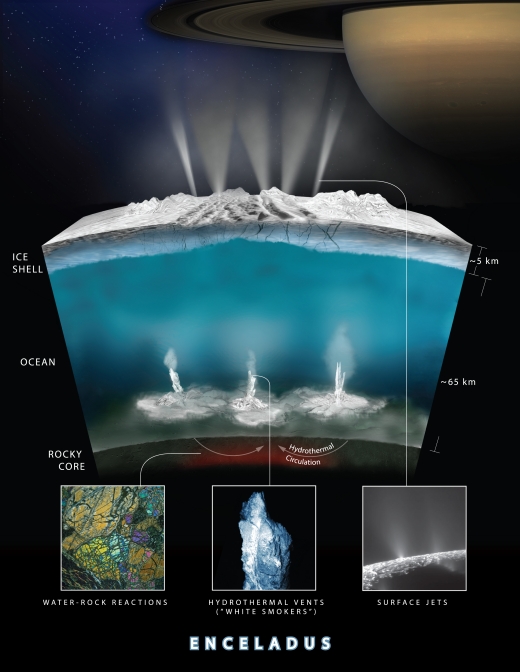
Image: The Cassini spacecraft detected hydrogen in the plume of gas and icy material spraying from Enceladus during its deepest and last dive through the plume on Oct. 28, 2015. This graphic illustrates a theory on how water interacts with rock at the bottom of the moon’s ocean, producing hydrogen gas. A Goddard team wants to develop an instrument that would reveal even more details about the hydrothermal vents and perhaps help answer if life exists on this ocean world. Credit: NASA/JPL-Caltech/Southwest Research Institute.
Gordon Chin (NASA GSFC), principal investigator for SELFI, describes it as a significant improvement over current submillimeter-wavelength technologies. Says Chin:
“Submillimeter wavelengths, which are in the range of very high-frequency radio, give us a way to measure the quantity of many different kinds of molecules in a cold gas. We can scan through all the plumes to see what’s coming out from Enceladus. Water vapor and other molecules can reveal some of the ocean’s chemistry and guide a spacecraft onto the best path to fly through the plumes to make other measurements directly.”
The GSFC team is using NASA R&D funding to increase the spectrometer’s sensitivity in the 557 GHz range, where the strongest signal from water is to be found. The goal is to explore the entire system of surface vents on Enceladus, measuring water and traces of other gases. The work also includes creating a radio frequency data-processing system, and a digital spectrometer for the RF signal that will convert it into digital signals to allow the measurement of the gases emerging from the plumes in terms of their quantity, temperature and velocity.
Calling it “one of the most ambitious submillimeter instruments ever built,” Chin says in this NASA overview that SELFI should be able to detect and analyze 13 molecular species, ranging from water in various isotopic forms to methanol, ammonia, ozone, hydrogen peroxide, sulfur dioxide, and sodium chloride. Work on the instrument is sufficiently encouraging that the GSFC team believes SELFI will eventually be part of a proposal for a future mission to Saturn.
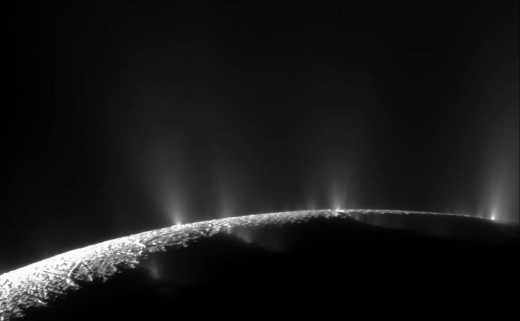
Image: Dramatic jets of ice, water vapor and organic compounds spray from the south pole of Saturn’s moon Enceladus in this image captured by NASA’s Cassini spacecraft in November 2009. Credit: NASA/JPL-Caltech/Space Science Institute.
Assuming it flies, the instrument should allow us to deduce the composition of the global ocean, and its potential for hosting extraterrestrial life. We have no idea whether Enceladus has warm hydrothermal vents of the sort that sustain life at the bottom of Earth’s ocean, but the prospect is enticing not only for this moon but for many of the other icy moons in the outer Solar System.
Into Saturn’s Depths
On the subject of Saturn, be aware as well of an interesting mission possibility called Hera, proposed as an M-class mission led by the European Space Agency, with collaboration from NASA (thanks Mike Fidler for the tip). The plan here is to detach an atmospheric probe from a ‘carrier-relay’ spacecraft as it approaches Saturn, letting the Hera probe enter Saturn’s atmosphere to study its tropopause, descending to pressure levels of at least 10 bars.
From the proposal page:
The primary science objectives will be addressed by an atmospheric entry probe that would descend under parachute and carry out in situ measurements beginning in the stratosphere to help characterize the location and properties of the tropopause, and continue into the troposphere to pressures of at least 10 bars. All of the science objectives, except for the abundance of oxygen, which may be only addressed indirectly via observations of species whose abundances are tied to the abundance of water, can be achieved by reaching 10 bars.

The Hera proposal recalls two previous missions, the first being the Galileo probe that was carried aboard the main Galileo spacecraft to Jupiter, entering the Jovian atmosphere on December 7, 1995 and continuing to function for close to an hour as it descended. The other analog is, of course, Cassini carrying the Huygens probe for the spectacular 2005 landing on Titan. That was a collaboration between ESA and NASA that paid off handsomely, and it provides a model for the carrier/data relay spacecraft model that Hera would use.

New Work on Planetary Inflation
Once in space in 2018, the Transiting Exoplanet Survey Satellite (TESS) will be observing, among many other things, hundreds of thousands of red giant stars across the entire sky. Planets around red giants are an interesting topic, because such stars point to an evolutionary outcome our own Sun will share, and we’d like to know more about what happens to existing planets in such systems as the host star swells and reddens, engulfing inner worlds.
New work out of the University of Hawaii Institute for Astronomy now examines two ‘hot Jupiters’ around red giants, stellar systems where we see the gas giants swelling up as the result of processes that remain controversial. The inflated size of planets like these can be explained in at least two ways, one of which involves a slowing of the cooling in the planet’s atmosphere, which causes the planet to inflate soon after formation. But the data presented here, drawn from NASA’s K2 mission, tend to corroborate the thinking of co-author Eric Lopez (NASA GSFC) that direct energy input from the host star is the dominant cause of this planetary inflation.
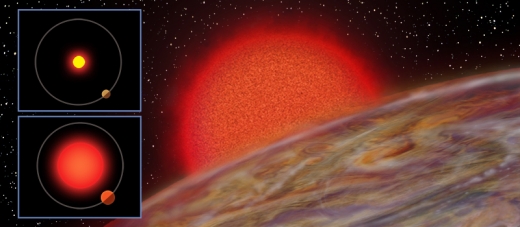
Image: Upper left: Schematic of the K2-132 system on the main sequence.
Lower left: Schematic of the K2-132 system now. The host star has become redder and larger, irradiating the planet more and thus causing it to expand. Sizes not to scale. Main panel: Gas giant planet K2-132b expands as its host star evolves into a red giant. The energy from the host star is transferred from the planet’s surface to its deep interior, causing turbulence and deep mixing in the planetary atmosphere. The planet orbits its star every 9 days and is located about 2000 light years away from us in the constellation Virgo. Credit: Karen Teramura, UH IfA.
The work is now available in The Astronomical Journal, where lead author Samuel Grunblatt and team show that each of the two planets is about 30 percent larger than Jupiter, though in each case only about half as massive. The two planets — K2-132b and K2-97b — are similar in orbital periods, radii and masses. Each orbits its red giant star in about nine days, with planetary radii being calculated at 1.31 ± 0.11 RJ and 1.30 ± 0.07 RJ respectively.
The researchers used models to analyze the evolution of planets like these over time, determining that their radii are typical for planets receiving their current level of radiation, but calculating back to main sequence values of radiation, they find the gas giants would have been considerably smaller. Stellar flux flowing to the planets’ deep convective interiors could therefore explain their current size, an indication that planet ‘inflation’ is directly tied to stellar irradiation rather than delayed atmospheric cooling after the planets’ formation.
But other factors remain to be tested, metallicity in particular. From the paper:
Further studies of planets around evolved stars are essential to confirm the planet re-inflation hypothesis. Planets may be inflated by methods that are more strongly dependent on other factors such as atmospheric metallicity than incident flux. An inflated planet on a 20 day orbit around a giant star would have been definitively outside the inflated planet regime when its host star was on the main sequence, and thus finding such a planet could more definitively test the re-inflation hypothesis. Similarly, a similar planet at a similar orbital period around a more evolved star will be inflated to a higher degree (assuming a constant heating efficiency for all planets). Thus, discovering such a planet would provide more conclusive evidence regarding these phenomena.
Also in play is the issue of heating efficiency, which may well vary between planets depending on their composition. Back to TESS, whose investigations should complement these results. Grunblatt and team point out that TESS should be able to observe additional planets in roughly 10 day orbits around more evolved stars, including oscillating red giants. The data should allow us to distinguish between the delayed cooling possibility and stellar irradiation scenarios.
The paper is Grunblatt et al., “Seeing Double with K2: Testing Re-inflation with Two Remarkably Similar Planets around Red Giant Branch Stars,” Astronomical Journal Vol. 154, No. 6 (27 November 2017). Abstract / preprint.

